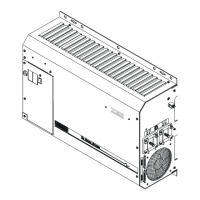MENU SYSTEM
Page
50
Copyright Trace Engineering Company, Inc.
5916 - 195th Street N.E.
Arlington, WA 98223
Telephone: 360/435-8826
Fax: 360/435-2229
www.traceengineering.com
PS Series Inverter/Charger
Part No. 3597
Rev. D: November 23, 1999
When RUN is selected as the function of the RY7 relay, the RY7 COM and RY7 N.O. contacts remain
closed while the generator is running. The RY7 N.C. (normally closed) contact is open (not connected to the
common terminal) while the generator is running. When the generator is off, the RY7 N.C. terminal is
connected to the RY7 COM terminal. This configuration is useful for starting a two wire (auto crank) type
generator.
When GLOWSTOP is selected as the function of the RY7 relay, the RY7 COM and RY7 N.O. contacts
remain open while the generator is running. The contacts close only when it is time for the generator to be
stopped, then re-open. This is useful for generators that require a stop signal to shut down the generator.
The GLOWSTOP setting can also be used for diesel generator. This relay can be used to provide both
the GLOW and STOP signals. When this is done the generator will be given both GLOW and STOP
signals before cranking and when stopping.
Set Gen warmup
seconds 20
All Models
Range: 16 to 255
Sets the number of seconds the generator is allowed to warm up before the load is connected and the
battery charger started. If the generator is located in a cold location, a longer setting may be required.
Set Pre Crank
seconds 10
All Models
Range: 00 to 255
Sets the number of seconds the system delays closing of relay RY8 - the start signal relay - once relay RY7
is closed. See the AUTOMATIC GENERATOR START MODE for more information. This period may also
be the amount of time that the glow plugs will be on if they are connected to the automatic start system.
Set Max Cranking
seconds 10
All Models
Range: 01 to 15
Sets the maximum number of seconds the starter will be cranked during the starting sequence by closing
relay RY8. See the AUTOMATIC GENERATOR START MODE for more information.
Set Post Crank
seconds 30
All Models
Range: 00 to 255
Sets the number of seconds the system will delay after completing the start sequence. If the generator
has not started, this sequence will be repeated up to 5 times. See the AUTOMATIC GENERATOR
START MODE for more information. This period is provided to allow the starter motor to cool off. It can
also allow generators with built in warm-up delay contactors to provide AC output before the inverter
attempts a re-crank cycle.
MENU HEADING - AUXILIARY RELAYS R9 R10 R11 (14)
Two voltage-controlled relays (RY9 and RY10) and an AC output fault relay (R11) are provided on the
optional AUX RELAY MODULE. RY9 and RY10 can perform battery voltage related tasks to simplify
installations and RY11 engages when there is no AC voltage on the output. RY11 is also available on the
GEN RELAY MODULE
These relays are single pole double throw, five amp relays. The terminals used to connect the external
wiring and the COM (common) terminals of the relays are separated and both the N.O. (normally open) and
N.C. (normally closed) contacts of each relay is provided. The operation of the relays are individually
controlled and adjustable. The two auxiliary relays operate independently of inverter/charger status (being
on or off). The relay state (engaged or disengaged) is maintained until the SET AUX RELAY VOLTS DC
setting or the ‘SET AUX RELAY VOLTS DC minus the HYSTERESIS VOLTS DC’ setting is met, then the
relay will change its state. Both the normally open (N.O.) and normally closed (N.C.) contacts are available
for each of these auxiliary relays.
CAUTION: These relays are not intended to directly control a load or charging source - rather they can be
used to send a signal or operate the coil of another higher amperage device which does the actual
switching of the power. A fuse rated at 5 amps or less should be included to protect each of the
relays. Damage to these relays from overloading is not covered by warranty and requires the inverter to
be returned to a repair center. This also applies to the relays that are provided to start a generator.

